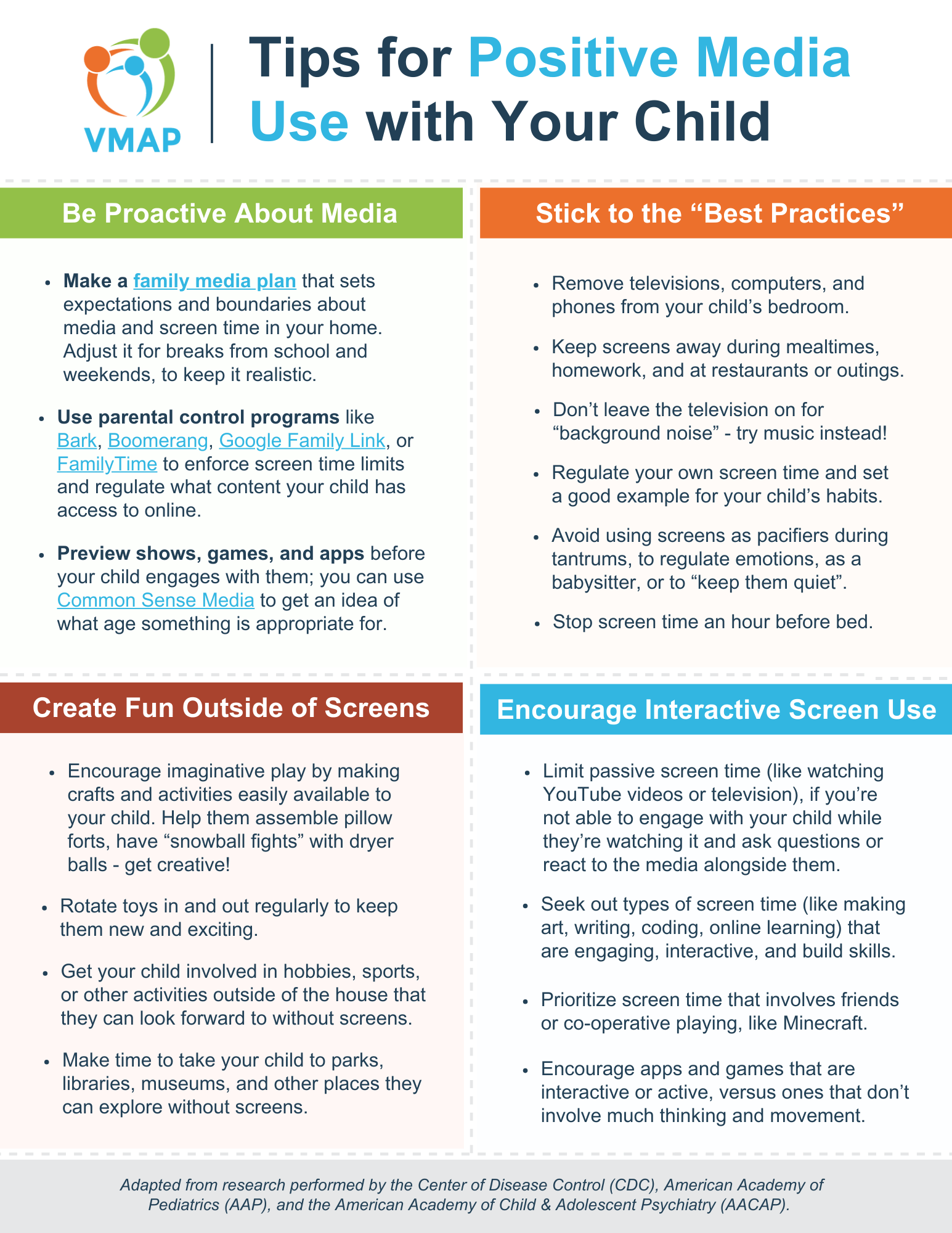How Much Screen Time is Safe for My Child?
Data on average daily screen time isn't available for children under 8 years old. However, with the rise of "iPad kids", it's not far-fetched to imagine that toddlers and young children are spending lots of time on screens. We have a clearer picture of media use for children and teens in elementary, middle, and high school, with these estimates of daily screen time averages from the CDC.
- 8-10 years old = 6 hours
- 11-14 years old = 9 hours
- 15-18 years old = 7.5 hours
This might seem alarming, but in this day and age, it's impossible to completely avoid screens – and we don't have to. In fact, the CDC, AAP, and AACAP don't have official guidelines for screen time, other than that it should be avoided for infants and children. There's lots of factors that are more important than the amount of screen time your child gets – and here are just a few!
Screen Time Considerations for Your Child
-
Quality vs Quality
Less screen time is always ideal, but the quality of media your child engages with is one of the most important considerations. Choosing higher quality media, such as Sesame Street, can improve cognitive, literacy, and social outcomes for children 3 – 5 years of age. To help determine what, Common Sense Media has compiled a list of educational televisions shows for kids, which you can view here!
-
Type of Screen Time
There are different types of screen time, and are more valuable than others. Here are the four main types, according to Common Sense Media:
- Passive: mindlessly watching videos or shows, scrolling, on autopilot
- Interactive: playing games, educational
- Communication: video-chatting, using social media
- Content creation: making digital art or music, coding
There's a place for all these forms of screen time, but content creation and interactive are some of the most beneficial for your child's development!
-
The "Three C's" of Media
We love to utilize the "Three C's" of media when creating positive media experiences for children and teens – content, co-viewing, and communication. Here's a little more about each one!
- Content: The quality and type of screen time – is it high-quality, slow-paced media? Is it interactive or creative?
- Co-viewing: Are you watching or engaging with the media alongside your child? Are you asking them questions about it and experiencing it with them?
- Communication: Do you have a family media plan that outlines boundaries around media? Do you talk to your child about how to stay safe online and recognize inappropriate content?
Tips for Regulating & Reducing Your Child’s Screen Time
-
Be Proactive About Media
- Make a family media plan that sets expectations and boundaries about media and screen time in your home. Adjust it for school breaks and weekends, to keep it realistic.
- Use parental control programs like Bark, Boomerang, Google Family Link, or FamilyTime to enforce screen time limits and regulate what content your child has access to online. 
- Preview shows, games, and apps before your child engages with them; you can use Common Sense Media to get an idea of what age something is appropriate for.
-
Stick to the "Best Practices"
- Remove televisions, computers, and phones from your child's bedroom.
- Keep screens away during mealtimes, homework, and at restaurants or outings.
- Don't leave the television on for "background noise" – try music instead!
- Regulate your own screen time and set a good example for your child's habits.
- Avoid using screens as pacifiers during tantrums, regulating emotions, as a babysitter, or to "keep them quiet".
- Stop screen time an hour before bed.
-
Create Fun Outside of Screens
- Encourage imaginative play by making crafts and activities easily available to your child. Help them assemble pillow forts, have "snowball fights" with dryer balls – get creative!
- Rotate toys in and out regularly to keep them new and exciting.
- Get your child involved in hobbies, sports, or other activities outside of the house that they can look forward to without screens.
- Make time to take your child to parks, libraries, museums, and other places they can explore without screens.
-
Encourage Interactive Screen Use
- Limit passive screen time (like watching YouTube videos or television), if you're not able to engage with your child while they're watching it and ask questions or react to the media alongside them.
- Seek out types of screen time (like making art, writing, coding, online learning) that are engaging, interactive, and build skills.
- Prioritize screen time that involves friends or co-operative playing, like Minecraft.
- Encourage apps and games that are interactive or active, versus ones that don't involve much thinking and movement.





